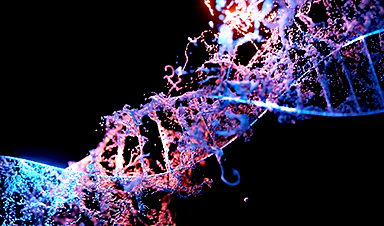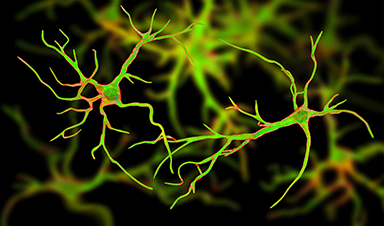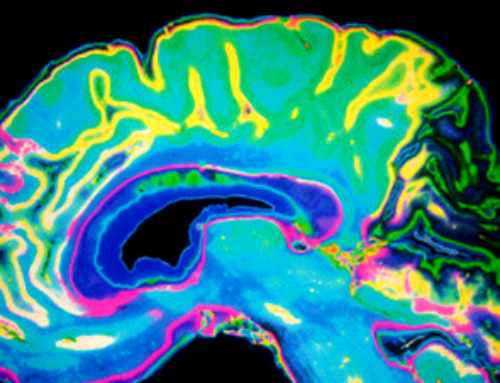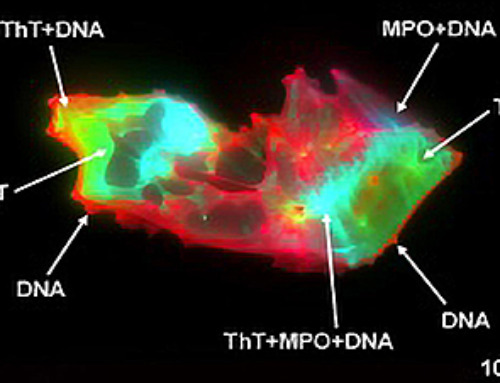In humans and other multicellular organisms, cells multiply. This defining feature allows embryos to grow into adulthood, and enables the healing of the many bumps, bruises and scrapes along the way.
Certain factors can cause cells to abandon this characteristic and enter a zombie-like state known as senescence where they persist but no longer divide to make new cells. Our bodies can remove these senescent cells that tend to pile up as we age. The older we get, however, the less efficient our immune systems become at doing so.
“In addition to no longer growing and proliferating, the other hallmark of senescent cells is that they have this inflammatory program causing them to secrete inflammatory molecules,” said Peter Adams, Ph.D., director and professor of the Cancer Genome and Epigenetics Program at Sanford Burnham Prebys and senior and co-corresponding author of the study.
Cells “running” this inflammatory program are considered to exhibit the senescence-associated secretory phenotype (SASP). Too many cells with SASP secreting inflammatory molecules can contribute to chronic inflammation in the body. This pervasive inflammation—called “inflammaging”—has been linked to many age-related diseases.
Scientists at Sanford Burnham Prebys and collaborators across the country published findings in Nature Communications showing that the mitochondria powering our cells also control the ability of a DNA repair protein to suppress SASP, which may reduce or delay inflammaging.
The research team turned human cells senescent by exposing them to radiation and then used those cells to demonstrate that DNA fixer tumor protein p53 suppressed SASP and one of its triggering events, the formation of cytoplasmic chromatin fragments (CCF).
These fragments are bits of damaged DNA that have been spewed from the cells’ nuclei into the gel-like cytoplasm that occupies the space in the cell between the outer membrane and central nucleus. The presence of DNA where it does not belong can trigger the immune system and contribute to SASP.
The scientists validated their findings in mice by treating them with a drug developed by cancer researchers to activate p53 as a way of suppressing tumors. In aged mice, the drug did not reduce the number of senescent cells but instead reversed the cellular signature that marks age-associated SASP, potentially stopping the inflammatory pollution that can lead to inflammaging.
In addition, the investigators discovered that senescent cells suffer from dysfunction in the mitochondria, serving as cells’ primary source of energy. Stressed mitochondria can cause senescent cells to form CCF and dampen the expression of the gene carrying the blueprint for p53.
“Altogether, we’ve identified a cellular circuit capable of promoting DNA repair and genome integrity while suppressing the dangerous inflammatory feature of senescent cells that contribute to age-related diseases,” said Karl Miller, Ph.D., staff scientist in the Adams lab at Sanford Burnham Prebys and lead and co-corresponding author of the study.
“We also have shown that this pathway can be modified by existing drugs in cultured cells and mice, so it may be possible to one day design a treatment that targets p53 to promote healthier aging.”
More information: Karl N. Miller et al, p53 enhances DNA repair and suppresses cytoplasmic chromatin fragments and inflammation in senescent cells, Nature Communications (2025). DOI: 10.1038/s41467-025-57229-3
News
Tiny Metal Nanodots Obliterate Cancer Cells While Largely Sparing Healthy Tissue
Scientists have developed tiny metal-oxide particles that push cancer cells past their stress limits while sparing healthy tissue. An international team led by RMIT University has developed tiny particles called nanodots, crafted from a metallic compound, [...]
Gold Nanoclusters Could Supercharge Quantum Computers
Researchers found that gold “super atoms” can behave like the atoms in top-tier quantum systems—only far easier to scale. These tiny clusters can be customized at the molecular level, offering a powerful, tunable foundation [...]
A single shot of HPV vaccine may be enough to fight cervical cancer, study finds
WASHINGTON -- A single HPV vaccination appears just as effective as two doses at preventing the viral infection that causes cervical cancer, researchers reported Wednesday. HPV, or human papillomavirus, is very common and spread [...]
New technique overcomes technological barrier in 3D brain imaging
Scientists at the Swiss Light Source SLS have succeeded in mapping a piece of brain tissue in 3D at unprecedented resolution using X-rays, non-destructively. The breakthrough overcomes a long-standing technological barrier that had limited [...]
Scientists Uncover Hidden Blood Pattern in Long COVID
Researchers found persistent microclot and NET structures in Long COVID blood that may explain long-lasting symptoms. Researchers examining Long COVID have identified a structural connection between circulating microclots and neutrophil extracellular traps (NETs). The [...]
This Cellular Trick Helps Cancer Spread, but Could Also Stop It
Groups of normal cbiells can sense far into their surroundings, helping explain cancer cell migration. Understanding this ability could lead to new ways to limit tumor spread. The tale of the princess and the [...]
New mRNA therapy targets drug-resistant pneumonia
Bacteria that multiply on surfaces are a major headache in health care when they gain a foothold on, for example, implants or in catheters. Researchers at Chalmers University of Technology in Sweden have found [...]
Current Heart Health Guidelines Are Failing To Catch a Deadly Genetic Killer
New research reveals that standard screening misses most people with a common inherited cholesterol disorder. A Mayo Clinic study reports that current genetic screening guidelines overlook most people who have familial hypercholesterolemia, an inherited disorder that [...]
Scientists Identify the Evolutionary “Purpose” of Consciousness
Summary: Researchers at Ruhr University Bochum explore why consciousness evolved and why different species developed it in distinct ways. By comparing humans with birds, they show that complex awareness may arise through different neural architectures yet [...]
Novel mRNA therapy curbs antibiotic-resistant infections in preclinical lung models
Researchers at the Icahn School of Medicine at Mount Sinai and collaborators have reported early success with a novel mRNA-based therapy designed to combat antibiotic-resistant bacteria. The findings, published in Nature Biotechnology, show that in [...]
New skin-permeable polymer delivers insulin without needles
A breakthrough zwitterionic polymer slips through the skin’s toughest barriers, carrying insulin deep into tissue and normalizing blood sugar, offering patients a painless alternative to daily injections. A recent study published in the journal Nature examines [...]
Multifunctional Nanogels: A Breakthrough in Antibacterial Strategies
Antibiotic resistance is a growing concern - from human health to crop survival. A new study successfully uses nanogels to target and almost entirely inhibit the bacteria P. Aeruginosa. Recently published in Angewandte Chemie, the study [...]
Nanoflowers rejuvenate old and damaged human cells by replacing their mitochondria
Biomedical researchers at Texas A&M University may have discovered a way to stop or even reverse the decline of cellular energy production—a finding that could have revolutionary effects across medicine. Dr. Akhilesh K. Gaharwar [...]
The Stunning New Push to Protect the Invisible 99% of Life
Scientists worldwide have joined forces to build the first-ever roadmap for conserving Earth’s vast invisible majority—microbes. Their new IUCN Specialist Group reframes conservation by elevating microbial life to the same urgency as plants and [...]
Scientists Find a Way to Help the Brain Clear Alzheimer’s Plaques Naturally
Scientists have discovered that the brain may have a built-in way to fight Alzheimer’s. By activating a protein called Sox9, researchers were able to switch on star-shaped brain cells known as astrocytes and turn them into [...]
Vision can be rebooted in adults with amblyopia, study suggests
Temporarily anesthetizing the retina briefly reverts the activity of the visual system to that observed in early development and enables growth of responses to the amblyopic eye, new research shows. In the common vision [...]





















